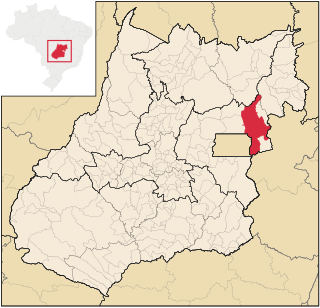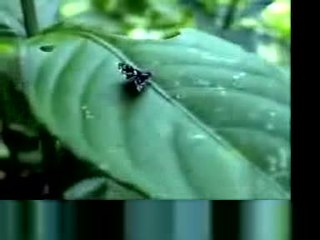
In the material culture of classical antiquity, a phiale or patera is a shallow ceramic or metal libation bowl. It often has a bulbous indentation in the center underside to facilitate holding it, in which case it is sometimes called a mesomphalic phiale. It typically has no handles, and no feet. Although the two terms may be used interchangeably, particularly in the context of Etruscan culture, phiale is more common in reference to Greek forms, and patera in Roman settings, not to be confused with the Greek (Πατέρας) Patéras or Father.

A tarantula hawk is a spider wasp (Pompilidae) that preys on tarantulas. Tarantula hawks belong to any of the many species in the genera Pepsis and Hemipepsis. They are one of the largest parasitoid wasps, using their sting to paralyze their prey before dragging it to a brood nest as living food; a single egg is laid on the prey, hatching to a larva which eats the still-living prey.

Formosa is a municipality located in the state of Goiás, Brazil, approximately 80 kilometers east of Brasília. The population was 123,684 in a total area of 5,813.637 km2. Formosa is known for its waterfalls and natural environment. It is a large producer of cattle and grains and is one of the fastest growing cities in the state.

A vial is a small glass or plastic vessel or bottle, often used to store medication as liquids, powders or capsules. They can also be used as scientific sample vessels; for instance, in autosampler devices in analytical chromatography. Vial-like glass containers date back to classical antiquity; modern vials are often made of plastics such as polypropylene. There are different types of vials such as a single dose vial and multi-dose vials often used for medications. The single dose vial is only used once whereas a multi-dose vial can be used more than once. The CDC sets specific guidelines on multi-dose vials.

Phiale is a genus of jumping spiders that was first described by Carl Ludwig Koch in 1846. P. albovittata has been considered a junior synonym of Freya perelegans since 2006.
Uluella is a monotypic genus of Panamanian jumping spiders containing the single species, Uluella formosa. It was first described by Arthur Merton Chickering in 1946, and is found in Panama.

Wedoquella is a genus of South American jumping spiders that was first described by María Elena Galiano in 1984. They reach a body length of about 5 to 11 millimetres, and are most closely related to Phiale in general appearance. The genus name is an arbitrary combination of letters with the suffix "-ella".

The Phiale Painter was a painter of the Attic red-figure style. He was active around 460 to 430 BC. The Phiale Painter is assumed to have been a pupil of the Achilles Painter. In contrast to his master, he liked to depict narrative scenes. He painted several large chalice kraters, often with two registers of figures; unlike his master, he seems to have preferred larger vessels in general. This is shown by his white-ground works, which are not well known, but more expressive than those of the Achilles Painter. Apart from a number of lekythoi, he painted two chalice kraters in white-ground technique, a rarity at the time. His themes may be partially influenced by contemporary theatre. His preferred name for kalos inscriptions is that of Euaion, son of Aeschylus. His conventional name is based on the fact that a painted phiale, a vase shape rarely equipped with figural depictions, is known from him.

Brenthia hexaselena is a species of moth of the family Choreutidae. It is found in Costa Rica. It is a rare example of a prey animal mimicking its predator.
P. flavescens may refer to:

Poecilotheria formosa is a species of tarantula, commonly known as the salem ornamental, beautiful parachute spider, or finely formed parachute spider.

Caladenia formosa, commonly known as the large crimson spider orchid, or elegant spider orchid is a plant in the orchid family Orchidaceae and is endemic to Victoria and South Australia. It is a ground orchid with a single hairy leaf and a single crimson-coloured flower and which mainly occurs only in south-western Victoria.
Rhene formosa is a jumping spider species in the genus Rhene that lives in Guinea. The female was first identified in 2002.
Phiale elegans is a species of spiders of the jumping spider family, Salticidae.

Euryopis formosa is a species of cobweb spider in the family Theridiidae. It is found in the United States and Canada.

Marpissa formosa is a species of jumping spider in the family Salticidae. It is found in the United States.
Phiela or Phiale was a coastal town of ancient Bithynia located on the Bosphorus.
Tapsatella is a monotypic genus of jumping spiders containing the single species, Tapsatella albocastanea. It was first described by Gonzalo Rubio and Cristian Stolar in 2020, and is only known from Chaco Province, Argentina. The genus may be related to some species of Wedoquella and Phiale. It was placed in the tribe Aelurillini, part of the Salticoida clade of the subfamily Salticinae.












